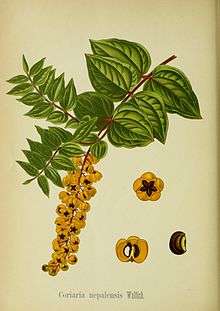Coriaria nepalensis
Coriaria nepalensis is a shrub of the genus Coriaria. It grows in the foot hills of Himalayas. It blooms in spring and has bright yellow flowers and red fruits in summer.[2]
| Coriaria nepalensis | |
|---|---|
 | |
| Scientific classification | |
| Kingdom: | Plantae |
| Clade: | Tracheophytes |
| Clade: | Angiosperms |
| Clade: | Eudicots |
| Clade: | Rosids |
| Order: | Cucurbitales |
| Family: | Coriariaceae |
| Genus: | Coriaria |
| Species: | C. nepalensis |
| Binomial name | |
| Coriaria nepalensis | |
| Synonyms[1] | |
|
Coriaria kweichowensis Hu | |
The plant is also known in English as masuri berry, tanner's tree, or mansur shrub. In Hindi it is known as masuri (मसूरी), makola, or masurya (मसूरिया); and in Nepali as macchaino (मछाईनो).[3]
Description
C. nepalensis is a shrub, growing around 1.5-2.5 metres tall. Flowers, yellow in colour, are in groups (inflorescences) and they are male or female but in the same plant. It blooms from February to May.[1]
Fruits are red to dark purple when mature. They resemble berries, but they are actually achenes protected by enlarged and colored petals. The fruits are produced from May to August, but they are inedible as their seeds are poisonous.[1]
The number of chromosomes the plant has is 40.[4]
Distribution
C. nepalensis grows on the southern slopes of the Himalayas (in Bhutan, India, Nepal, Pakistan), usually between 800 and 2500 metres.[5]
This species was also found in southern China in mountain slopes at 200–3200 m high. It has been found in the Chinese provinces of Gansu, Guangxi, Guizhou, Henan, Hong Kong, Hubei, Hunan, Jiangsu, Shaanxi, Sichuan, Xizang, Yunnan.[6]
References
- Tien-lu Ming; Anthony R. Brach. "Coriaceae" (PDF). Retrieved 10 February 2013.
- Tropicos.org. "Coriaria nepalensis Wall". Missouri Botanical Garden. Retrieved 10 February 2013.
- "Coriaria nepalensis". Flowers of India. Retrieved 22 February 2013.
- Yokoyama, J.; Suzuki M.; Iwatsuki K. & Hasebe M. (2000). "Molecular phylogeny of Coriaria, with special emphasis on the disjunct distribution". Molecular Phylogenetics and Evolution. 14 (1): 11–19. doi:10.1006/mpev.1999.0672. PMID 10631039.
- Abdul Ghafoor. "Coriaria nepalensis". Flora of Pakistan. Retrieved 2013-02-10.
- Tien-lu Ming; Anthony R. Brach. "Coriaria nepalensis". Flora of China. Retrieved 2013-02-10.
External links
| Wikispecies has information related to Coriaria nepalensis |